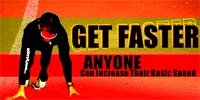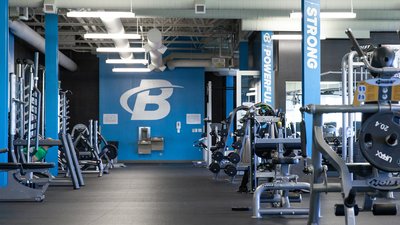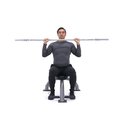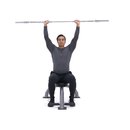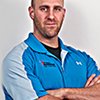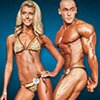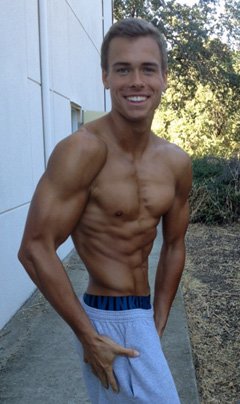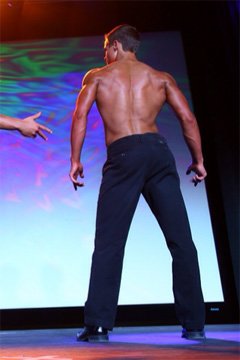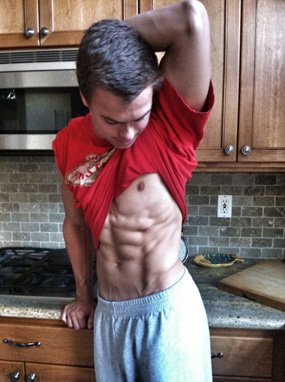Week 1 Schedule:
| Sat. 7 | Quad City Steamwheelers | Cedar Rapids River Kings | 7:05 PM CST | |||
| Sun. 8 | San Diego Strike Force | Bismarck Bucks | 2:05 PM CDT | |||
Conditioning and Nutrition For Football. from Bodybuilding.com
The following is designed to address these issues and respond to questions that I thought may be of interest to athletes and coaches alike about football...

Introduction

We all know that great football players are big and fast, but those of us who have no direct experience playing or coaching football typically know little about what other characteristics are important to success in football.
Likewise, most of us are unaware of how coaches condition their players, what the most common injuries to players are, and how diets for football players differ from diets of other athletes.
The following is designed to address these issues and respond to questions that I thought may be of interest to athletes and coaches alike.

[ Q ] What three physical characteristics are most useful in predicting which high-school athletes might become successful interior linemen, running backs, linebackers or defensive backs? Is bigger always better?

- The single most important characteristic is speed. If other physical attributes are at least average, speed will determine which athletes will advance to the elite level.
 | ||||
 |
|  | ||
 | ||||
Other critical factors include reaction time (an important component of agility), vertical jumping ability (as a marker for power of the lower body), and upper body strength.
All things being equal, in a contact sport like football, a larger player generally has an advantage over a smaller one, but in the real world, especially at the high school level, bigger is not necessarily better. The high school lineman often has to play both sides of the ball, and a player with better quickness and skill can often overcome a larger opponent.
Speed in general, and specifically the ability to accelerate quickly, is without question the single most important physical factor, regardless of position. Speed can make up for deficits in either strength or skill.
Upper-body strength and reaction time are two other characteristics that are necessary to be a successful football player, especially at the positions of interior lineman, running back, and defensive back. Bigger isn't necessarily better if the athlete excels in the other characteristics.

[ Q ] What are the most important strength exercises that should be emphasized for football players? How important are weight-room exercises compared to on-field, football-specific exercises such as blocking-sled drills?

- Those exercises that improve strength in the "core" muscle group are the most important ones.
The core is defined as the lumbar-pelvic-hip complex and consists of the gluteals, abdominals, hip flexors, and spinal muscles. The core is where our center of gravity is located and where all power movements begin. Squats, dead lifts, leg presses, abdominal curls against resistance, and leg raises are excellent exercises for developing the core musculature.
Of course, upper body strengthening with bench presses, military presses, and various exercises to strengthen elbow flexors and extensors are also important for football players.
The combination of developing a good strength base in the weight room and developing the technical ability to execute a skilled movement at a high speed during field drills is the key to successfully enhancing performance of a power movement. Without speed, strength will not allow the athlete to generate adequate power.
Time spent in the weight room building core strength is essential for the successful football athlete. Other more sport-specific drills are also important but are probably not as efficient for building sheer strength and power.

[ Q ] What are your two most favorite on-field conditioning drills for football players? Why do you think these drills are important?

- Pre-practice drills are important to teach proper technique. Begin practice with a moderately long run to raise body temperature and follow this with static stretching of all major muscle groups.
Next, have the players perform a series of sprints, stride stretches, and plyometric rebound jumps on one and two legs. These drills do a fantastic job of preparing the athlete's body, particularly the joints, for the rigors of practice and competition.
During the first five days of practice before heavy contact work, have players also perform agility circuits. Set up 10 stations with various drills: plyometrics with resistance, grass drills, running against elastic ropes for resistance, jumping ropes, and one-legged running. At each station, have players work for one minute at high intensity before moving on to the next station.
Try to design these drills to be as specific as possible to football. During the main part of the season, select from a menu of high-intensity intervals (repeat 40-yard sprints), long slow distance runs, and a variety of football-specific agility drills.

[ Q ] What approach do you take to conditioning players for training and competition in hot weather?

- The single most important factor is to make certain that the athletes are physically fit. Certainly they must be appropriately hydrated and gradually acclimatized to exercising in extreme environmental conditions, but if they are not fit to begin with, they will be more likely to experience heat-related problems.
Educate the players about the importance of avoiding dehydration and its detrimental effects on performance and health. Cajole, beg and insist that they drink enough fluids during hot and/or humid conditions.

[ Q ] How do you try to prevent and/or treat dehydration and muscle cramps in football players?

- Contrary to what some people think, there is no way to train to withstand the adverse effects of dehydration. Players should be offered both water and an electrolyte replacement drink during practice and competition, and in hot weather they should be encouraged to drink frequently.
Athletes prone to muscle cramps may need to take in more sodium and potassium in salted sports drinks and in their daily diets.
Encourage players to consume a sports drink before, during, and after practice. Guidelines are: 16-20 oz (450-600 ml) 1-2 hours before exercise, 7-10 oz (200-300 ml) every 15-20 minutes during exercise, and at least 24 oz (720 ml) after exercise for each pound lost. Players should be weighed before and after practice to assess average fluid losses. They should be reminded to drink before they are thirsty and to drink on a schedule.
 | ||||
 |
|  | ||
 | ||||
Players should carry a squeeze bottle with them during the day so that they can drink between workouts, classes, and practice. They should know the warning signs of dehydration: dizziness or lightheadedness, cramping, nausea, fatigue and dark-colored urine.
Some players are cramp-prone. These players tend to sweat early and very heavily. They typically have a history of cramping and produce sweat that tastes salty. Some are following a low-salt diet due to a family history of high blood pressure. They also tend to be the most fit and athletic players at their positions.
For these players, we add 1/4-1/2 teaspoon of salt to 16 oz of a sports drink and encourage them to eat more salt in their daily diets.

[ Q ] What are the most common injuries to football players? What are the best approaches to preventing these injuries?

- In my experience, the most common injuries are contusions, followed by muscle strains (e.g., hamstrings, quadriceps, calf), muscle cramps, ankle sprains and knee sprains.
The likelihood of injury can be reduced by making certain the athlete engages in a well-organized and supervised year round training and conditioning program at an appropriate level of intensity and occasionally under extreme environmental conditions.
Strength training and skill training are the best approaches to preventing these injuries. Strength training protects the joints from trauma, and skill training can help prevent injury by improving the athlete's proprioception, i.e. his ability to judge the position of his body and its parts in space.

[ Q ] Do football players typically need diets that are different from those for most other sports? If so, how are football diets different?

- Football players competing at the college level have extraordinary energy and fluid needs. They also have very busy schedules and must balance training, practice, competition, classes and homework. The challenge is to keep them fueled and hydrated.
Overall energy (calorie) needs and specific nutrient requirements vary depending on time of season, body weight, maturity, personal food preferences and position played.
For example, an offensive lineman is focused on strength and power, whereas a running back is more concerned with quickness and agility. I develop meal plans accordingly to meet the individual nutrition and performance goals of the athlete.
The timing of calorie intake is important. The ideal eating pattern for athletes is grazing, i.e. eating small meals throughout the day, to maximize energy intake for training and recovery.
 | ||||
 |
|  | ||
 | ||||
Quick recovery is especially important for football players because they often work out more than once per day. Calorie needs should be met with high-energy, nutrient-dense foods. Consuming enough carbohydrate (8-9 g/kg or 4 g/lb of body weight) from foods such as fruit, cereals, breads, rice, pasta, vegetables, and some dairy foods each day will minimize fatigue and maximize training.
Protein needs (1.6-1.7 g/kg or 0.8 g/lb body weight) can be met with lean protein sources, including meat, poultry, fish, dairy foods, eggs, legumes and nuts. Getting enough protein on a daily basis can be a challenge for college players due to budget constraints.

Calculate Your Protein Needs:
- Often, college athletes simply do not have the financial resources to buy the amount of food they need to meet overall energy and nutrient needs.
Large players need to take in more total calories than do most other athletes. Sometimes the sheer volume of food necessary to achieve this can be overwhelming for the athlete. This is where nutritional supplements such as carbohydrate energy drinks and meal replacement beverages can be useful.

[ Q ] Do you recommend nutritional supplements for football players? If so, which ones? If not, why not?

- Football players are interested in supplements that are marketed to increase mass, enhance recovery, provide energy and burn fat. Most players mistakenly believe that if a supplement is available over the counter it must be safe, legal and effective.
College athletic departments are particularly concerned about supplement use among athletes because of the potential for these supplements to be contaminated with banned substances. Any student who tests positive for a banned substance such as anabolic steroids or ephedrine is ineligible for participation in regular season and postseason competition for one year.
Institutions may not provide substances such as amino acids, chondroitin, creatine, glucosamine, l-carnitine, and protein powders to athletes, but the athletes may use these supplements on a personal basis.
Players need to know and want to know what dietary supplements they can use and how to use them appropriately. An important role of the sports nutritionist is to help athletes make informed decisions.
I believe that a team approach is essential for determining supplement policy and procedure because each team member, administrator, nutritionist, physician, trainer, coach and strength coach looks at the issue a little bit differently. Supplements are evaluated in terms of their safety, effectiveness, potency, dosage and risk-benefit ratio.

| Athletes.com - No Banned Substances!
All products on Athletes.com are cross-referenced with the Prohibited/Banned Substances lists from all major athletic associations and world-wide anti-doping agencies. A few of these include: IOC (Olympic Committee), USADA (US Anti-Doping Agency), WADA (World Anti-Doping Agency), NCAA, NFL, and many others.
[ Click here to learn more. ] |

Key Points

- Speed is the most important physical characteristic for success in football. Although body size is important, reaction time and strength can overcome differences in size.
- To build strength, football players should concentrate on performing squats, leg presses, bench presses, dead lifts, power cleans and other resisted exercises that improve strength of large muscle groups of the trunk and legs.
- Improving physical fitness and educating athletes on the need to drink fluids before, during, and after exercise are important in preparing football players for practice and competition in hot weather. Sports drinks provide carbohydrate energy and sodium, which can help minimize cramping. All players should emphasize salty foods in their diets during hot weather, and cramp-prone players may need to add salt to their sports drinks.
- Contusions, stingers, muscle strains, and sprains of the ankle and knee are the most common injuries in football. Year-round training for strength and skill is the best preventive measure.
- In general, recommended diets for football players, as with other athletes, emphasize carbohydrates. Large players obviously require more calories, and players at certain positions and with specific nutritional goals may require individual dietary modifications.


